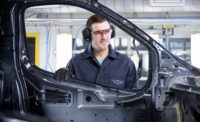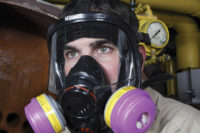Do you ever encounter resistance from a hearing-impaired worker about wearing hearing protection on the job? The OSHA Noise Standard does not discriminate between workers with and without hearing loss, or those who wear hearing aids and those who do not1. An estimated 10 million American workers have permanent hearing loss from occupational noise. This number increases yearly as the workforce ages2. Among those workers who wear hearing aids, two common misconceptions are:
1) thinking that because they already have a hearing loss, they are not affected by noise, and 2) that their hearing aids can be used as hearing protection. Neither of these arguments is valid.
 
|
|
Figure 1: A BTE hearing aid with integrated DAI used with a cable (a) and a miniature FM receiver (b). – Photo courtesy of Sonic Innovations, Inc. 2013. Used with permission. |
Regarding the first, the majority of hearing-impaired individuals have a “sensorineural” hearing loss. This type of hearing loss occurs in the cochlea. The most common cause of cochlear hearing loss is noise exposure, and the damage is cumulative. Once this type of hearing loss occurs, it cannot be restored and the remaining hearing can still be lost. Hearing aids do not restore hearing; they only make use of remaining hearing. The more hearing they have to work with, the better job they can do. This is why it is vitally important to protect residual hearing.
As to the second argument, frequently one hears, “I’ll just turn off my hearing aids and now I’ve got earplugs.” Most hearing aid fittings are “vented,” meaning there is a pathway for the noise from outside the ear to the eardrum. As with any hearing protection device (HPD), when there is a pathway for sound leakage, the device is no longer effective. Also, since most custom hearing aids and earmolds are made from hard acrylic and cannot change their shape, there is often additional sound leakage caused by jaw movement. Lastly, OSHA has addressed this issue succinctly: “Hearing aids are not hearing protectors3.”
Hearing-impaired workers struggle
Without hearing aids, hearing-impaired workers are at a disadvantage because the attenuation from HPDs is added to their hearing loss. Nevertheless, you can still comply with regulations, protect the worker’s residual hearing, and accommodate reasonable communication needs. In order to do so, safety professionals should be aware of three things:
- OSHA encourages workers who wear hearing aids to continue to do so and wear appropriate earmuffs over them4 as long as the worker’s 8-hour time-weighted average (TWA) noise exposure does not exceed allowable limits.
- Most modern hearing aids are equipped with features like programs for multiple listening environments, technology for speech understanding in noise, and algorithms to mitigate the squeal (acoustic feedback) that often occurs when hearing aids are covered or cupped.
-
HPDs are also available with technologies designed to enhance speech communication while protecting hearing.


Figure 2: A pocket or belt-mounted FM transmitter and receiver. The receiver has a neckloop that works with the telecoil in the ITE hearing hearing aid shown. Neckloops can also be connected directly to telephones, music players, and other audio devices as well. – Photo of FM system courtesy Comtek, Inc. 2013. Used with permission.
29 CFR 1910.95(i)(3) stipulates that employees be able to select from a variety of suitable HPDs. These should include HPDs that work with hearing aids. Subsections (i)(4) and (i)(5), however, make it the employer’s responsibility to ensure that employees are trained in proper use of the selected HPD. The safety professional has an opportunity to enlighten management as to the accommodations dictated by the hearing-impaired worker’s safety and communication requirements, and guide the worker in selecting hearing protection (most likely earmuffs) that ensures the best outcome with hearing aids. Among the little research done on hearing aids and earmuffs, a study by Verbsky5 showed that the use of hearing aids under earmuffs significantly improved speech understanding in noise for hearing-impaired workers compared to wearing earmuffs alone. For best results, however, the employee’s audiologist should be involved in the process of optimizing the hearing aids for use with earmuffs.
For sensorineural hearing losses, modern hearing aids apply the most amplification to soft sounds. To a hearing-impaired person, loud sounds still sound loud and do not need much amplification. Nearly all modern hearing aid algorithms are designed to help hearing aid wearers perceive a more “normal” dynamic range (the range from soft to loud): soft sounds that could not be heard before are now audible (but soft), and loud sounds are still loud because that is how they are naturally perceived. Hearing aid algorithms are designed for the audibility of speech and other everyday sounds — not industrial noise. In a noisy industrial environment, even if the noise is marginally below the action level, it is easy to exceed TWA exposure limits with hearing aids.
Advances in hearing aid technology
Modern hearing aids are technological marvels. Directional microphones and multiple listening programs are standard features on most basic digital hearing aids. Some models include “smart” microphones, digital noise reduction, and feedback cancellation. Properly implemented, these technologies can work harmoniously with the earmuff used by a hearing-impaired employee.
Some larger hearing aids may include additional technologies to improve communication in noise. A direct audio input (DAI), for example, bypasses the hearing aid microphone through a connector on the hearing aid. It can receive audio signals from radios, telephones, MP3 players (Figure 1a), miniature FM receivers (Figure 1b), and other communications devices. Many hearing aids also have a telecoil that picks up a telephone signal through electromagnetic induction and amplifies it through the hearing aid circuitry. Devices other than telephones can exploit telecoils as well, like induction loops worn under clothing around the neck. Neck loops can be plugged into the output of many audio devices — for instance, a pocket-sized or belt-mounted FM transmitter/receiver (Figure 2). A more recent development is *Bluetooth® connectivity that allows hearing aids to communicate wirelessly with another Bluetooth device with which they are paired. In all of these cases, hearing aids can often be worn under earmuffs while audio information is delivered to the hearing aids wirelessly or via a thin cable.
Some hearing aids are positioned behind the ear (BTE) and others are custom fit into the ear canal and/or concha (the bowl-shaped part) of the ear. Previously, BTE hearing aids were large and unattractive. Their size meant they could deliver more power and they also had more controls and features, but they also interfered with wearing earmuffs. Recent strides in hearing aid technology have shrunk the size of BTE hearing aids while still including many advanced features. As a result, BTE hearing aids are now the most popular hearing aid style6, and modern BTE hearing aids are likely to work better with earmuffs.
Custom hearing aids are also better than ever, from the largest in-the-ear (ITE) type to the smallest completely-in-the-canal (CIC) size. There are now small, non-custom hearing aids that fit deep into the ear canal and use new battery technology allowing them to remain in place for several months. It is possible to use banded, canal-cap type HPDs with these extended-wear hearing aids.

|
|
Figure 3:Uniformly-attenuating earmuffs. – Photo courtesy of Honeywell Safety Products |
Advances in HPD technology
HPD technology has also advanced significantly. Earmuffs are the most logical choice for employees wearing hearing aids. Among these are passive models (i.e., without circuitry) that attenuate noise uniformly across the frequency spectrum (Figure 3). When it comes to hearing-impaired workers, this is important because standard earmuffs attenuate high frequencies more than low frequencies and make important speech sounds too soft for a hearing-impaired worker. Low-frequency sounds (like most noise) more easily mask high-frequency sounds (like speech). This upward spread of masking is also reduced with uniformly-attenuating earmuffs.
The Verbsky study5 also looked at differences in speech-understanding-in-noise between standard earmuffs and uniformly-attenuating earmuffs. The findings suggest that uniformly-attenuating earmuffs may enhance communication in noise for both normal-hearing and hearing-impaired employees, especially when environmental noise is below 90 dB SPL. Hearing-impaired workers can receive significantly improved speech communication benefits while still protecting their hearing when they wear hearing aids under uniformly-attenuating earmuffs.
Earmuffs are available with communications circuitry. Active models (i.e., with battery-powered circuitry) incorporate microphones built into the ear cups, and connectors for external audio devices such as two-way radios, direct communications links, or MP3 players (Figure 4). There is a volume control to adjust the amplified sound from outside the ear cups and signals from the external audio input, but circuitry limits the output from the electronics to 82 dBA. Stereo microphones help preserve localization cues so spatial orientation and situational awareness are maintained.
Other active systems are designed as integrated high-noise solutions (Figure 5). Such systems have hearing protection and communications built into the ear canal interface. These systems include radio connections and ear-level stereo microphones for face-to-face conversation and situational awareness. Fit testing and in-ear dosimetry are built in as well. Communications are enhanced with automatic noise reduction designed to work with continuous, intermittent and impulsive noise.
Team efforts

|
|
Figure 4: Electronic earmuffs with true-stereo microphones, volume control, and output limiting circuit. – Photo courtesy of Honeywell Safety Products |
There are many ways in which modern HPDs and hearing aids can team up (see Sidebar), and it is not necessary to be a hearing aid expert to accommodate hearing-impaired employees. Feature-rich products alone, however, do not guarantee stellar performance. Many of the benefits derived from advanced hearing aids have to do with the skill of the professional who fits them. The hearing-impaired employee’s audiologist should be engaged as a team member for optimal results. When meeting with the audiologist, the employee should take along the earmuff — and any other personal protective equipment that could be a functional concern, like a respirator or a hard hat — that will be required to work with the hearing aids.
A skilled audiologist can assist with an assortment of solutions, including programming multi-program hearing aids with settings specific for use with earmuffs, and facilitate additional communication solutions like DAI, telecoil loops, and Bluetooth, as appropriate. The collaboration will also add an important resource to the safety professional’s network and serve to strengthen a culture of hearing loss prevention across professions and industries.
SIDEBAR
|
Hearing aids and HPDs play well together when they leverage each other’s best features. Following are practical guidelines for finding a solution for most hearing-impaired employees working in noise: |
|
1. If the employee does not need to communicate while wearing hearing protection, then hearing aids should be removed and any appropriate earmuff or earplug should be used. 2. If the employee is constantly donning and removing earmuffs and does not need to communicate while wearing hearing protection, then the employee can turn off the hearing aids and wear earmuffs over them. Hearing aids can be turned on again when earmuffs are removed. As long as overprotection is not a concern, earmuffs can be worn over hearing aids while they are turned off. 3. If the employee needs to wear hearing aids under earmuffs in order to communicate, then acoustic feedback from the hearing aids may occur. Most premium hearing aids have a feedback cancellation algorithm that the employee’s audiologist can optimize for use with earmuffs. Gain can be reduced with a volume control. Earmuffs with deeper ear cups may also help reduce acoustic feedback, but deeper ear cups usually mean greater attenuation and could result in overprotection. 4. If the employee needs to wear hearing aids under earmuffs in order to communicate, use uniformly-attenuating earmuffs. Uniformly-attenuating earmuffs are available in a variety of ear cup depths. 5. If the attenuation of a uniformly-attenuating earmuff is too low for the level of noise, or if communication is still too difficult while wearing uniformly-attenuating earmuffs, then electronic communication earmuffs may be worn over hearing aids set to an appropriate gain (the note about acoustic feedback still applies). Noise reduction is useful for enhancing speech understanding in noise. This is especially important for a hearing-impaired worker who already has trouble understanding speech. Not all hearing aid noise reduction algorithms are designed to improve speech understanding. Work with the audiologist to assess the effectiveness of hearing aid noise reduction algorithms. 6. If the employee’s hearing loss is mild, then electronic earmuffs may be able to amplify speech without hearing aids. However, electronic earmuffs should never be used as a general substitute for properly-fit hearing aids. 7. For specialized communication requirements, consider the use of DAI, telecoil and neck loop, FM, or Bluetooth, where available and appropriate. The audiologist can often find an optimal solution with these technologies. An integrated high-noise communications/HPD solution (see figure 4) should be considered in especially challenging environments. 8. If the noise level is so high that communication is impossible, then hearing aids should be removed and properly-fit HPDs worn that are appropriate for the level and type of noise to which the employee is exposed. 9. If double protection is required, hearing aids should never be substituted for an appropriately selected and properly-fit earplug under earmuffs. 10. If communication is critical to a job, but the employee’s hearing loss is too severe to communicate with hearing aids worn under earmuffs, then job reassignment is a reasonable and valid action. Administrative controls are specified by 29 CFR 1910.95(b) and management is expected to use them as a means of mitigating the risk of occupational hearing loss. |

|
|
Figure 5:A complete communications and hearing protection system, including stereo ear-level microphones and full duplex communications, radio interconnections, automatic noise reduction, built-in fit testing, and in-ear dosimetry. These systems are most useful in challenging environments where noise is high and situational awareness and communications is critical, like military, SWAT, drilling platforms, and mining environments. – Photo courtesy of Honeywell Safety Products |
References
1. Occupational Safety and Health Administration. (1970). 29 CFR 1910.95, Federal Register.
2. Occupational Safety and Health Administration. (2005). Safety and Health Information Bulletin - Innovative Workplace Safety Accommodations for Hearing-Impaired Workers [SHIB 07-22-2005]. Washington, D.C.: OSHA.
3. Occupational Safety and Health Administration. (2005). Safety & Health Information Bulletin - Hearing Impaired Workers [SHIB 12-27-2005]. Washington, D.C.: OSHA.
4. Occupational Safety and Health Administration. (3 August 2004). Letter of Interpretation to Tekla A. Staley.
5. Verbsky, B. (2002). Effects of conventional passive earmuffs, uniformly-attenuating passive earmuffs, and hearing aids on speech intelligibility in noise. Ph.D. Dissertation, Ohio State University, Columbus, OH. http://etd.ohiolink.edu/send-pdf.cgi/Verbsky%20Babette%20L.pdf?osu1038964671Accessed 24 May 2013.
6. Kochkin, S. (2010). MarkeTrak VIII: Consumer satisfaction with hearing aids is slowly increasing. The Hearing Journal, 63(1), 19 – 32.
*Bluetooth is a registered trademark of Bluetooth SIG



